Walking along the ramparts of Rothenburg, I came to a large observation tower, Burgtor, at which one may leave the old town and enter a small park or rather the “City Garden” (Burggarten), situated in a narrow and relatively long flat area around which there is a sharp decline towards the valley of the river Tauber. It seems like a long and narrow promontory, which is not surrounded by water, but by that steep drop of the terrain. At the end of that flat section, there are a couple of places where one may enjoy nice views of the surroundings.
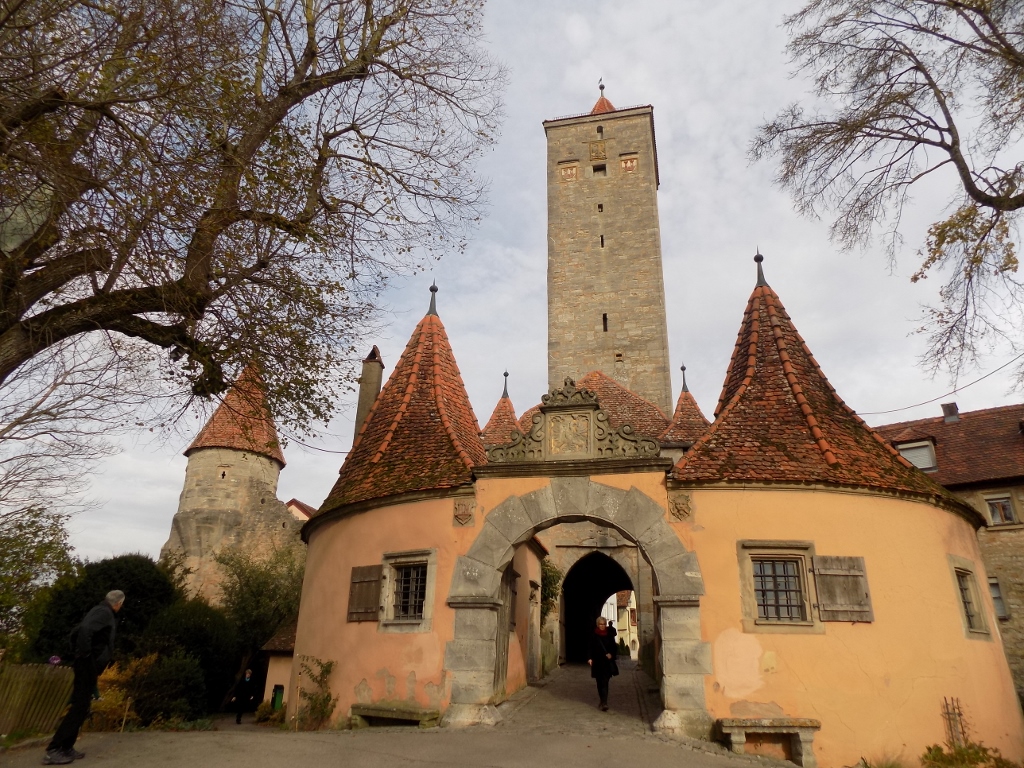 Burgtor
Burgtor
Still, before visiting the park, I found a detail in the part of the walls near the tower particularly interesting. It is located above the tunnel that connects the town and the park. The detail consists of a stone ornament on the wall in the form of a mask with openings where the eyes and the mouth are, and beside them two canals through which liquid might pass. I wonder if this was used in the past to pour hot oil on those trying to enter the town through this gate.
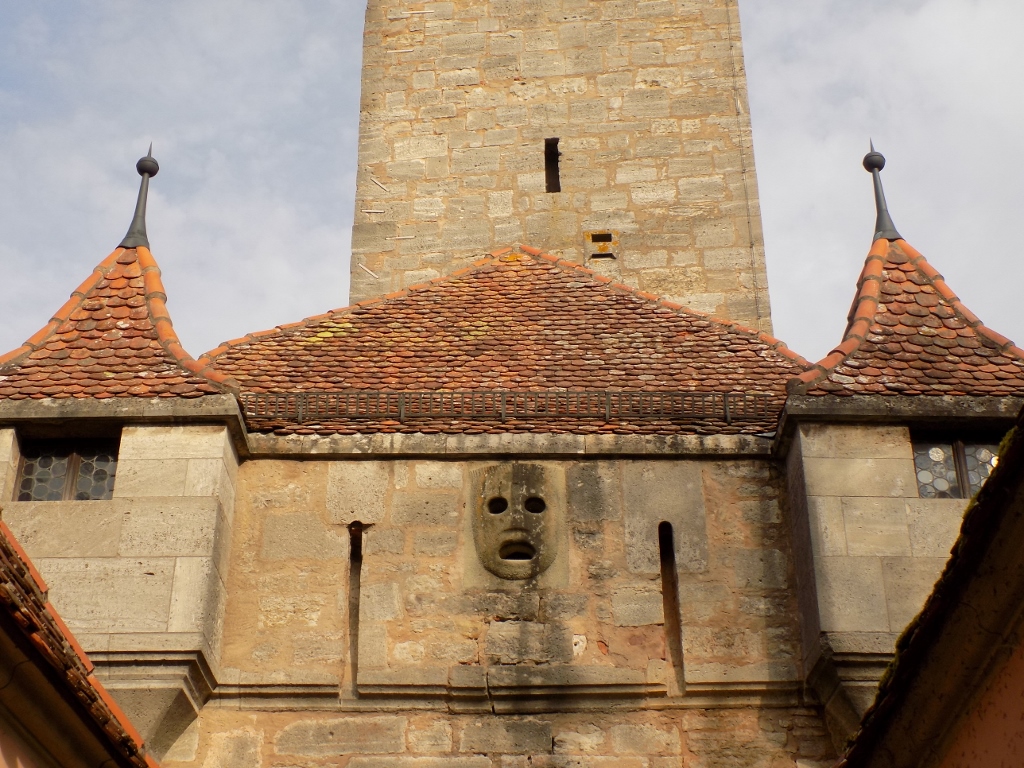 A detail from the gate at Burgtor
A detail from the gate at Burgtor
As for the park, it was indeed possible to enjoy in the nice views from there, but I guess it all looks even prettier in spring and summer when the trees are covered by green leaves, although full treetops may also hinder the view.
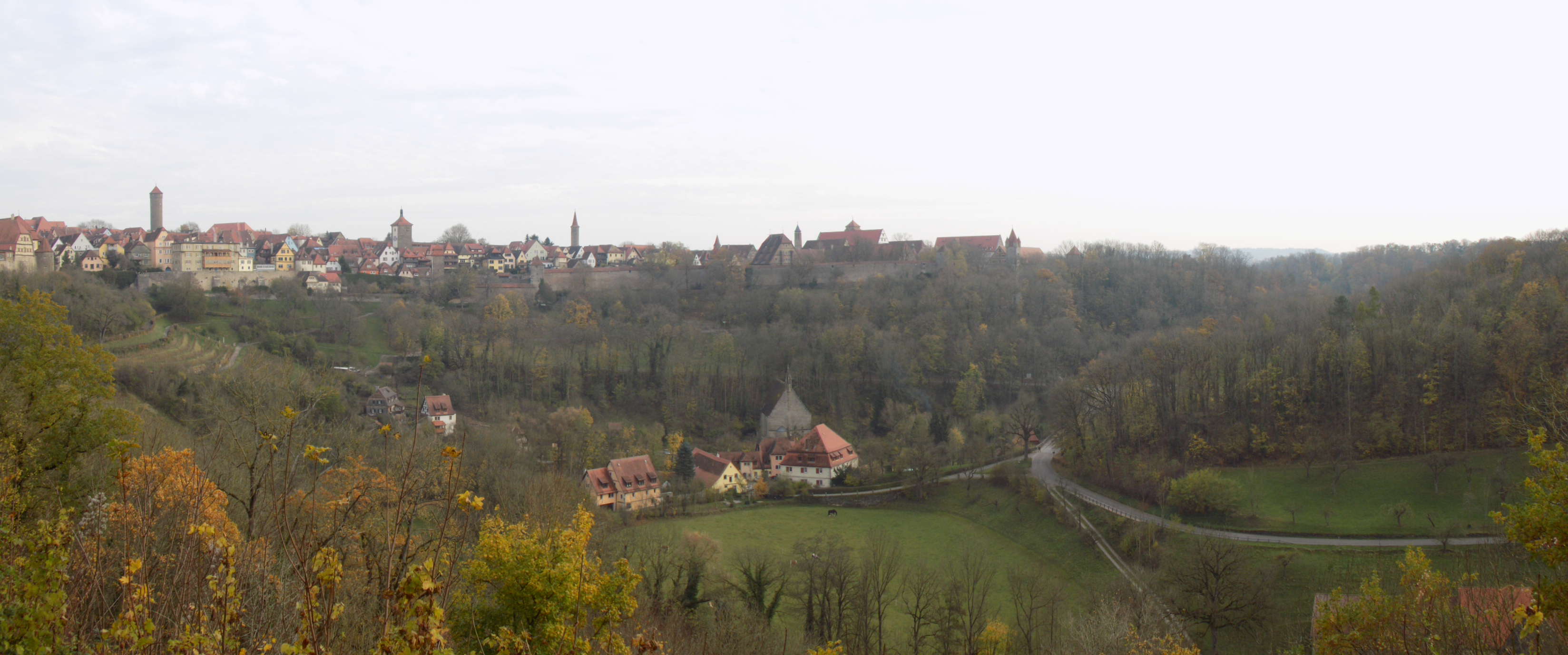
Through the valley under the terrace-like flat promontory, in addition to the river Tauber, there are also local roads and there are a couple of bridges. Near one of them there is a building of an unusual shape, the Topplerschlößchen – a residential house placed on top of a tower!
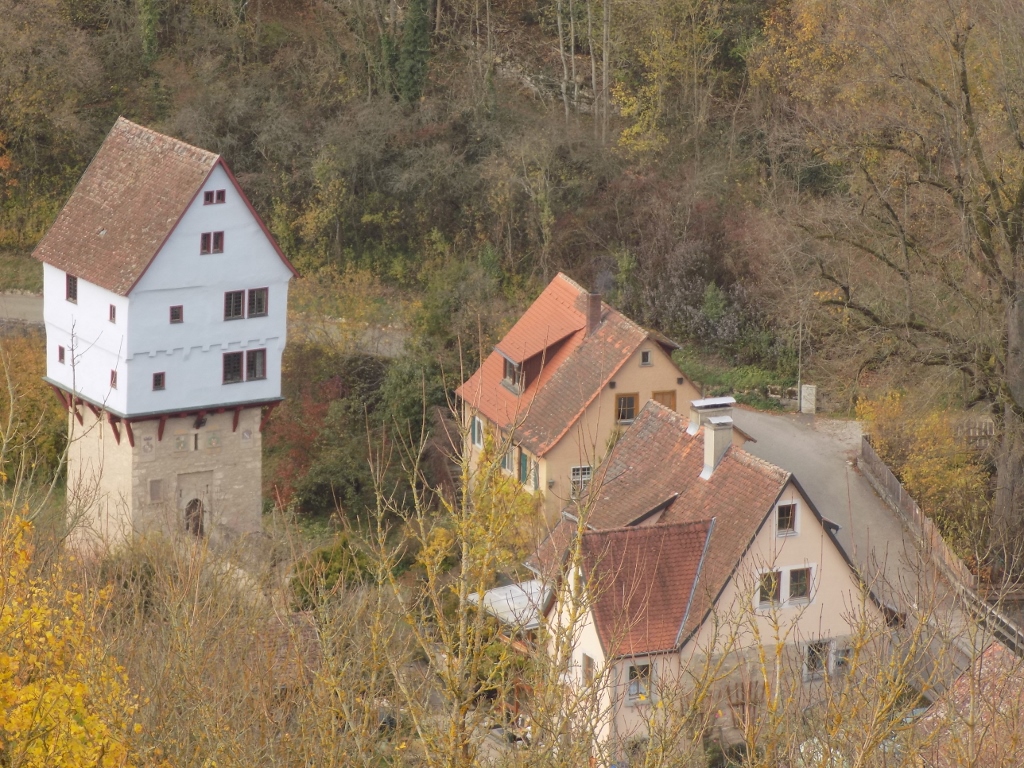 Topplerschlößchen
Topplerschlößchen
In the valley, near a church, there is also a Double Bridge (Doppelbrücke), that is, a two-tier stone bridge.
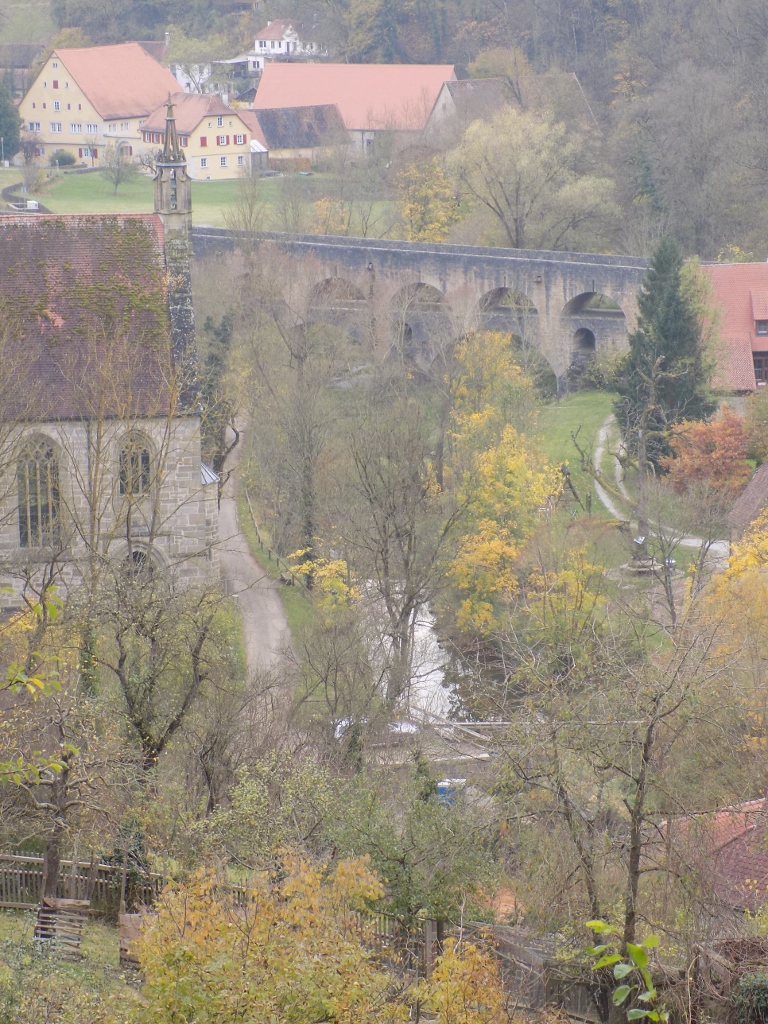 Church and the Doppelbrücke in the Tauber valley
Church and the Doppelbrücke in the Tauber valley
Then I continued following the ramparts and there were quite a few of nice and interesting sights. First I saw a large building whose windows on a high roof, which looked to me like some eyes, inevitably reminded me of India – as if these were the eyes of a divinity place at an extremely unlikely place. It is in fact a building in which there is a hostel.
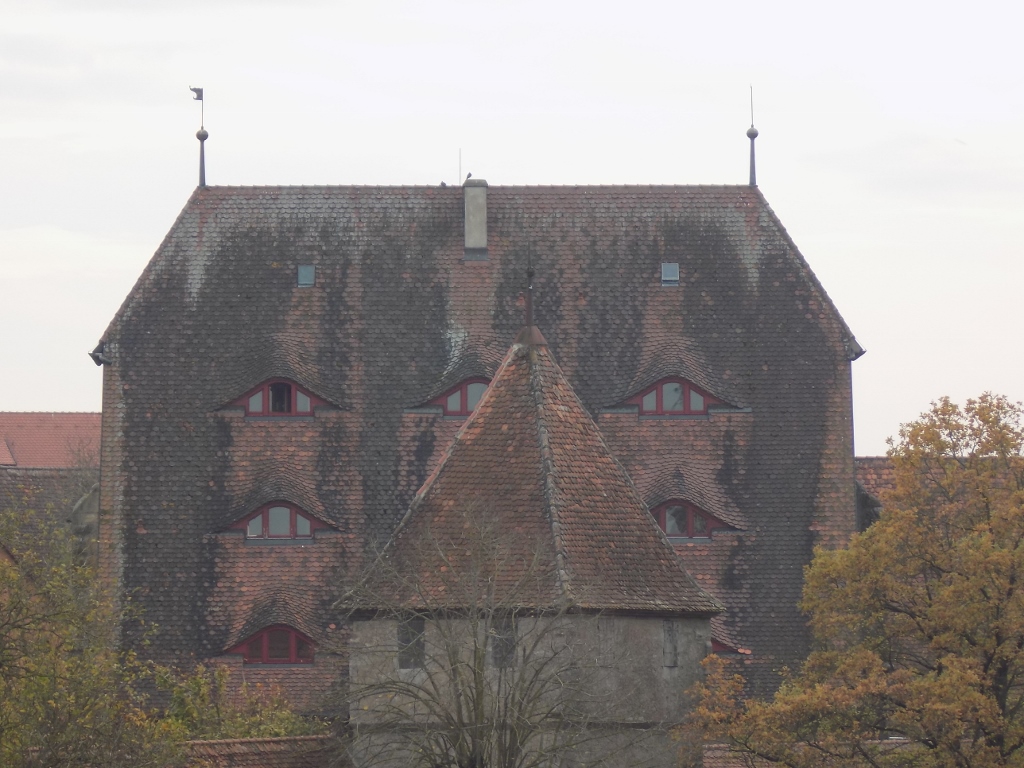 A hostel in Rothenburg with “eyes” in lieu of windows
A hostel in Rothenburg with “eyes” in lieu of windows
And before I reached the building housing the hostel, I passed by yet another semi-open passage, but this one was placed a little lower and actually served for entering a long building that followed the line of the ramparts. However, more than by the passage itself, my attention was caught by the fantastically maintained appearance of the ancient construction – I felt as if I had gone back in time. It was all old, but not falling to pieces.
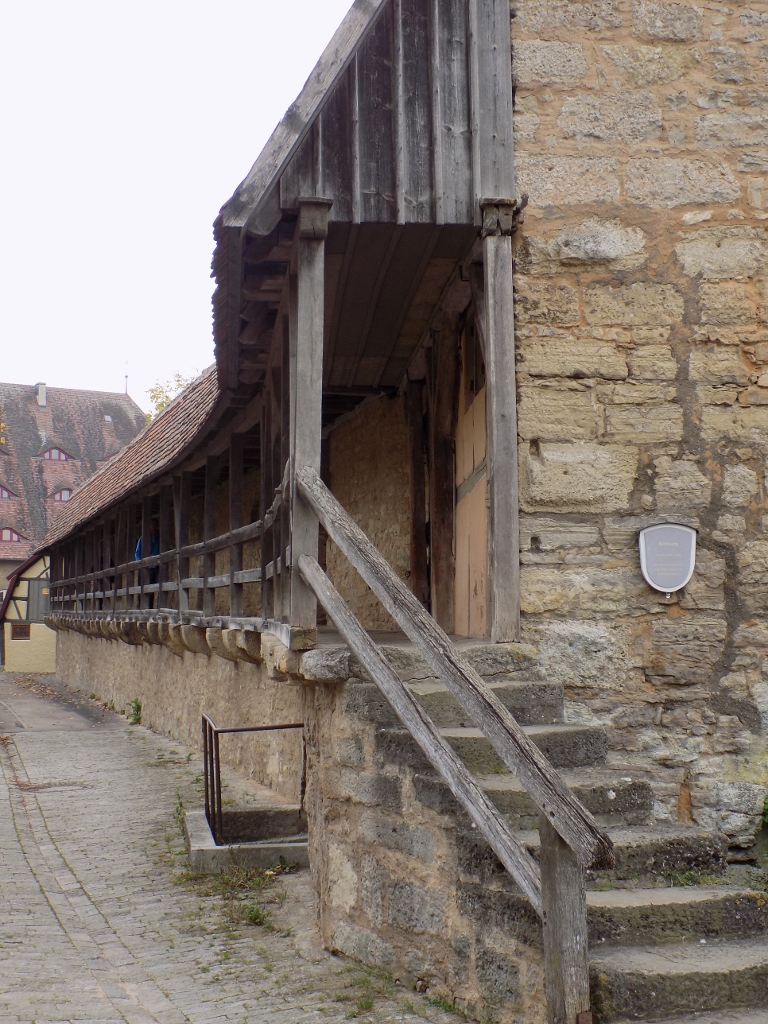 The old open hallway in the south section of Rothenburg
The old open hallway in the south section of Rothenburg
And finally, when one peers through some of the openings in the walls in this part of the town, near the Kalkturm tower, there is a stunning view at the centre of Rothenburg.
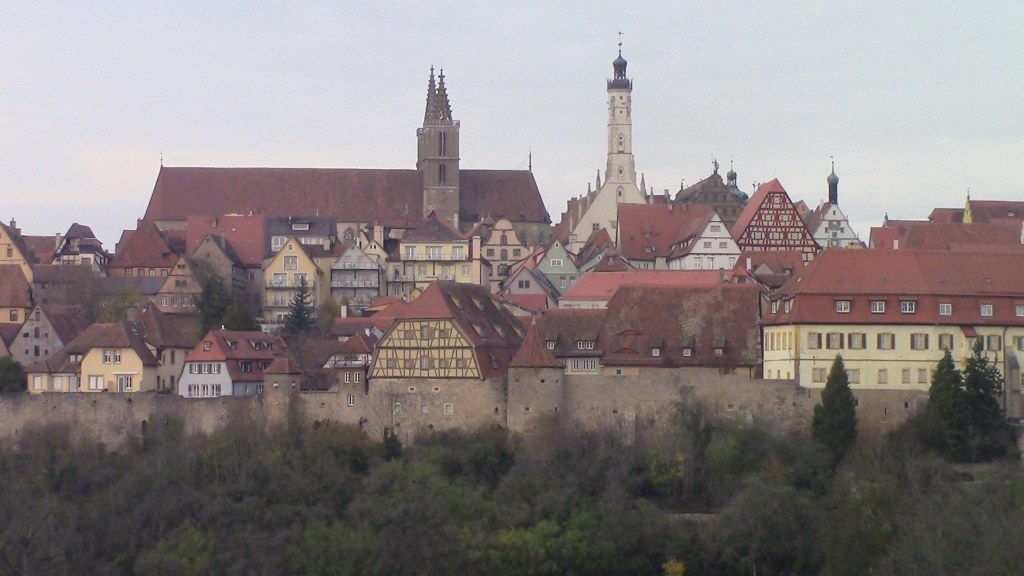 View at the centre of Rothenburg
View at the centre of Rothenburg
Going further, I reached a group of buildings from the 16th and the 17th centuries, which are jointly called the Spital, meaning the hospital. This is also the farthest south section of the old town, so there is another high observation tower and a gate called the Spitaltor. I walked around the area for a little while and even went completely outside the ramparts, but I soon returned to the old part of the town.
Once back, I continued coming across nice, as well as interesting details.
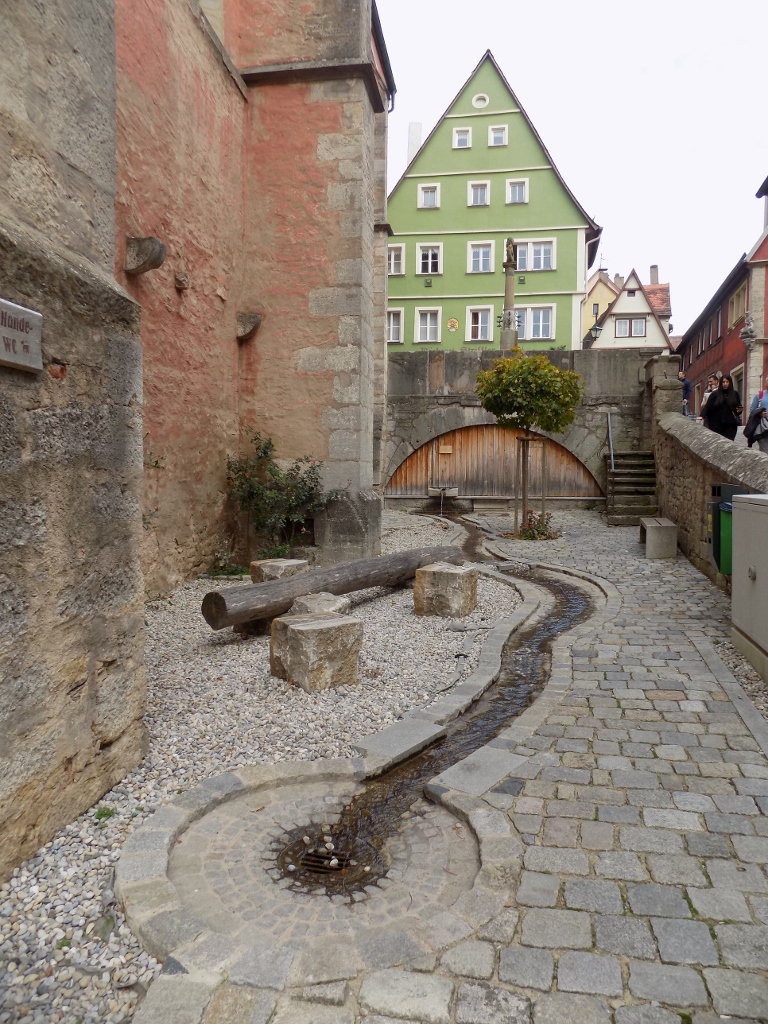 A water canal leading from a drinking-fountain made almost like a “Zen garden.” Still, the main thing in the picture is the small board on the wall to the left: “Dog toilet”
A water canal leading from a drinking-fountain made almost like a “Zen garden.” Still, the main thing in the picture is the small board on the wall to the left: “Dog toilet”
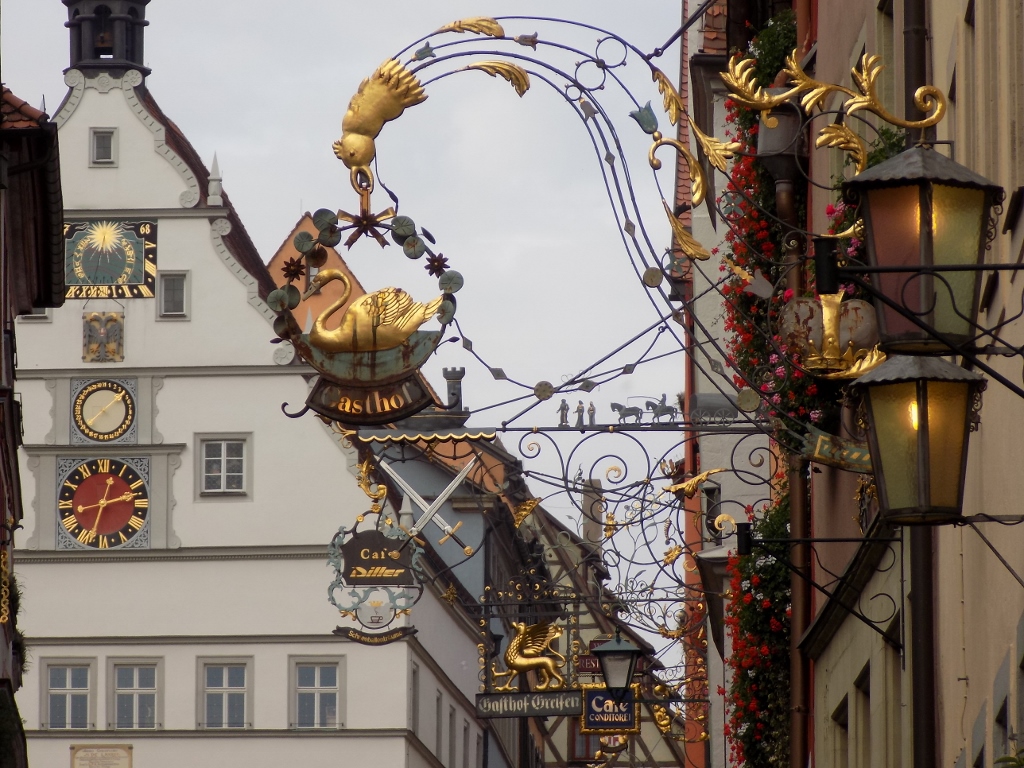 Signs for shops and cafés, with the Ratstrinkstube building in the back
Signs for shops and cafés, with the Ratstrinkstube building in the back
By this time I was quite tired and I supposed I was hungry, too. I’m saying this in this way for I often don’t feel hungry at all while visiting places. Whether the reason for that is the fact I’m moving and my stomach does not get enough blood to be able to notify its owner that it is empty or my brain is just too busy with the sightseeing, I don’t know, but this is something that often happens to me during my travels.
For this reason I decided to look for some sausages. Originally I had planned to go to a restaurant and have a decent late lunch, but in the meantime I had concluded it would be better to eat something informally and then to sit down and make a break for a coffee and some local sweet specialties. And this was what I eventually did. I came across a butcher’s shop that also grilled sausages and sold them in buns and that was really great.
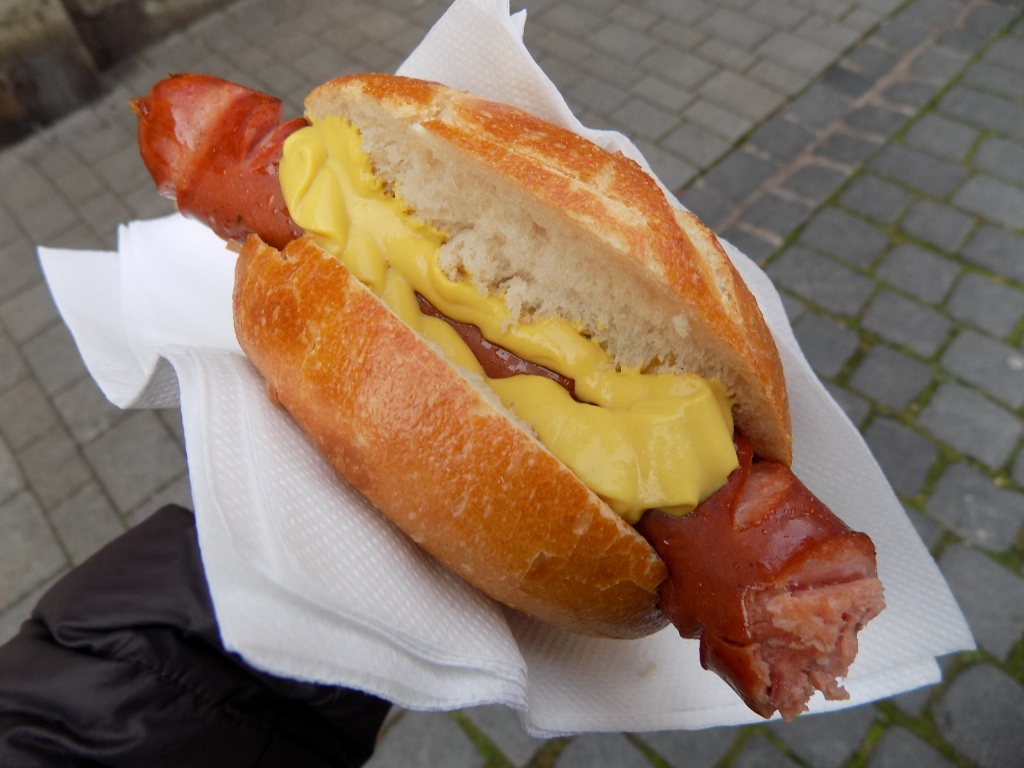 A sausage in a bun (it smelled so beautifully that I immediately started eating it, even before it occurred to me to take a photo)
A sausage in a bun (it smelled so beautifully that I immediately started eating it, even before it occurred to me to take a photo)
While eating the delicious sausage in a bun, I went through the centre again and then to the east part of the ramparts called the Stadtmauer.
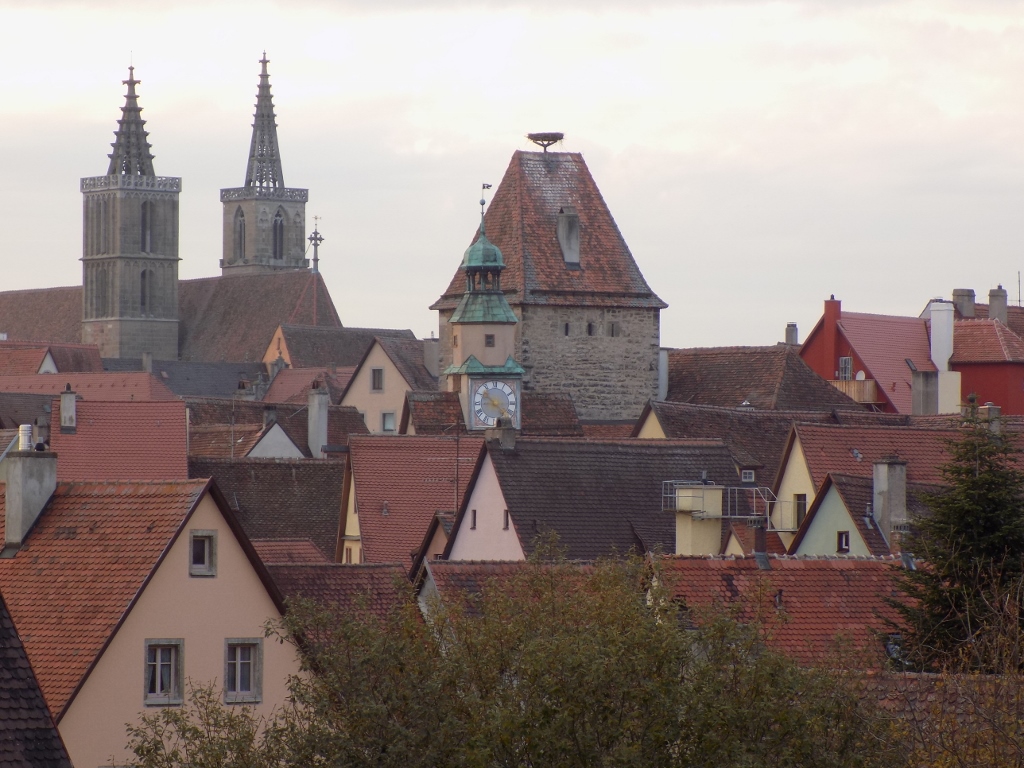 Rothenburg roofs
Rothenburg roofs
In addition to the wonderful views I had of the centre of the town, I also had a great view at a house that has a particularly interesting architecture. The original was completely destroyed in the 1945 bombing, but the building has been reconstructed since then and nowadays adorns Rothenburg in all of its beauty. This is the Gerlachschmiede.
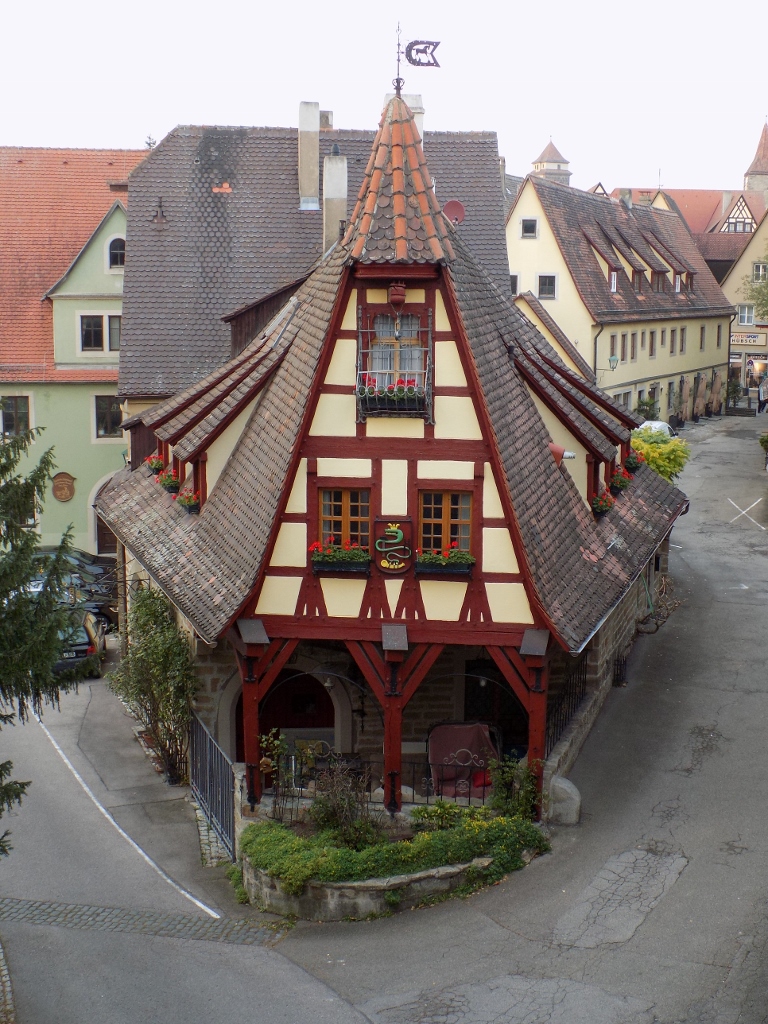 Gerlachschmiede
Gerlachschmiede
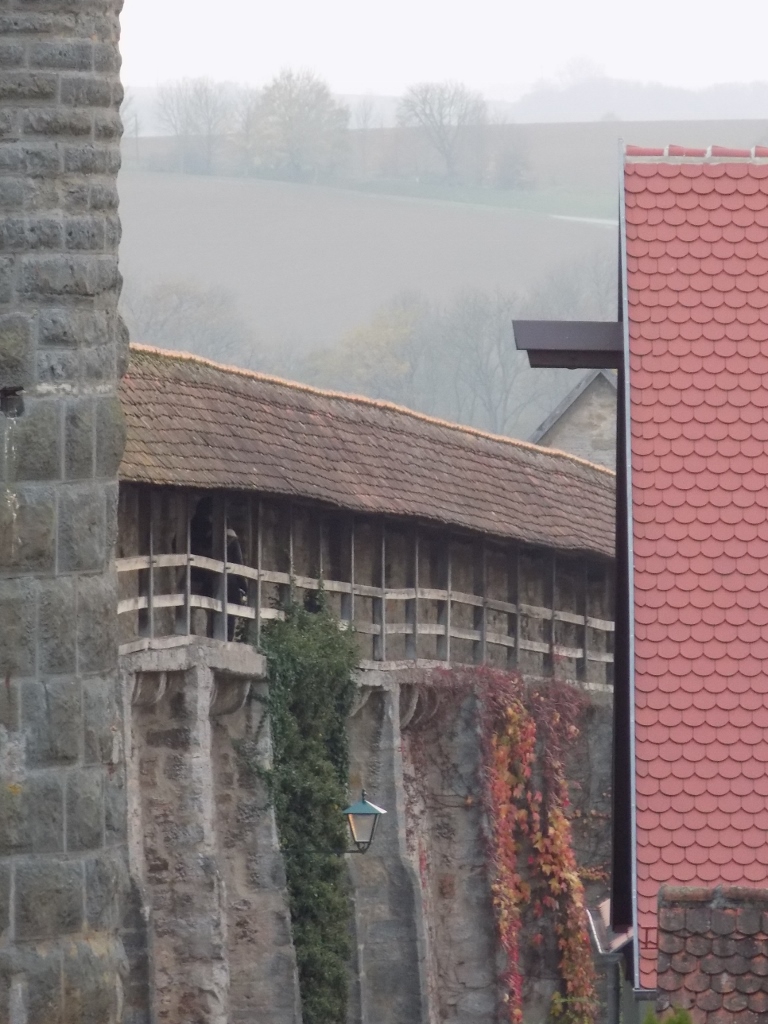 View towards an open hall-way leading along the ramparts
View towards an open hall-way leading along the ramparts
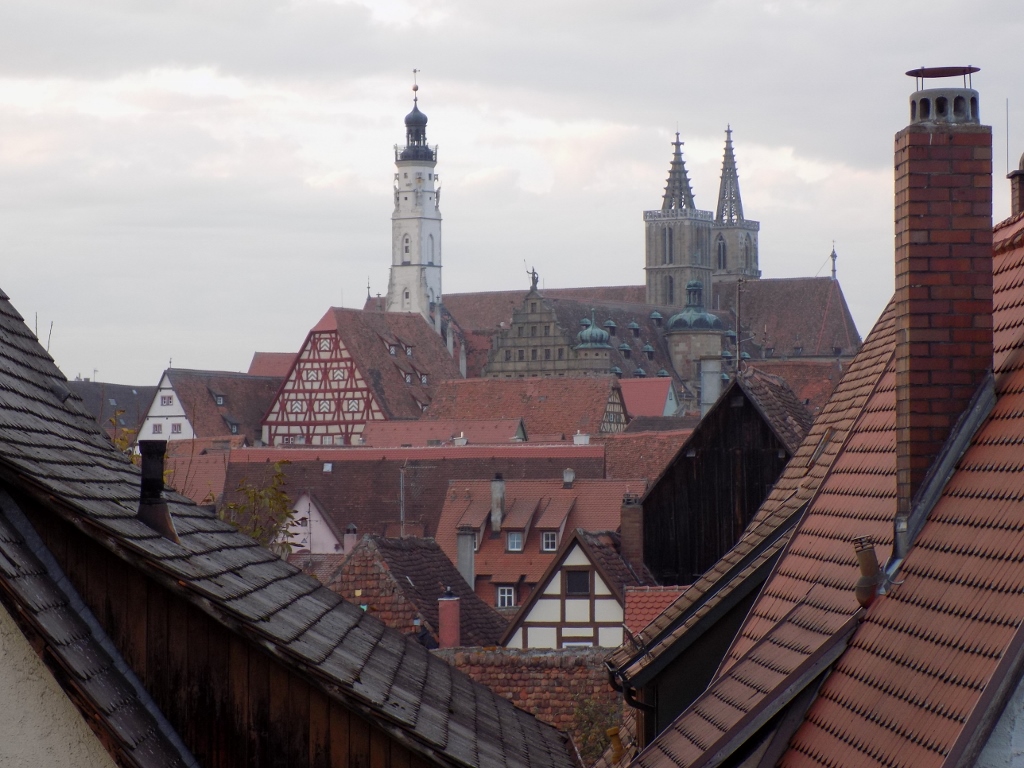 Roofs and the centre of Rothenburg
Roofs and the centre of Rothenburg
And then finally came the time for me to sit down and have a rest over a coffee and a local speciality – snowballs (Schneeballen).
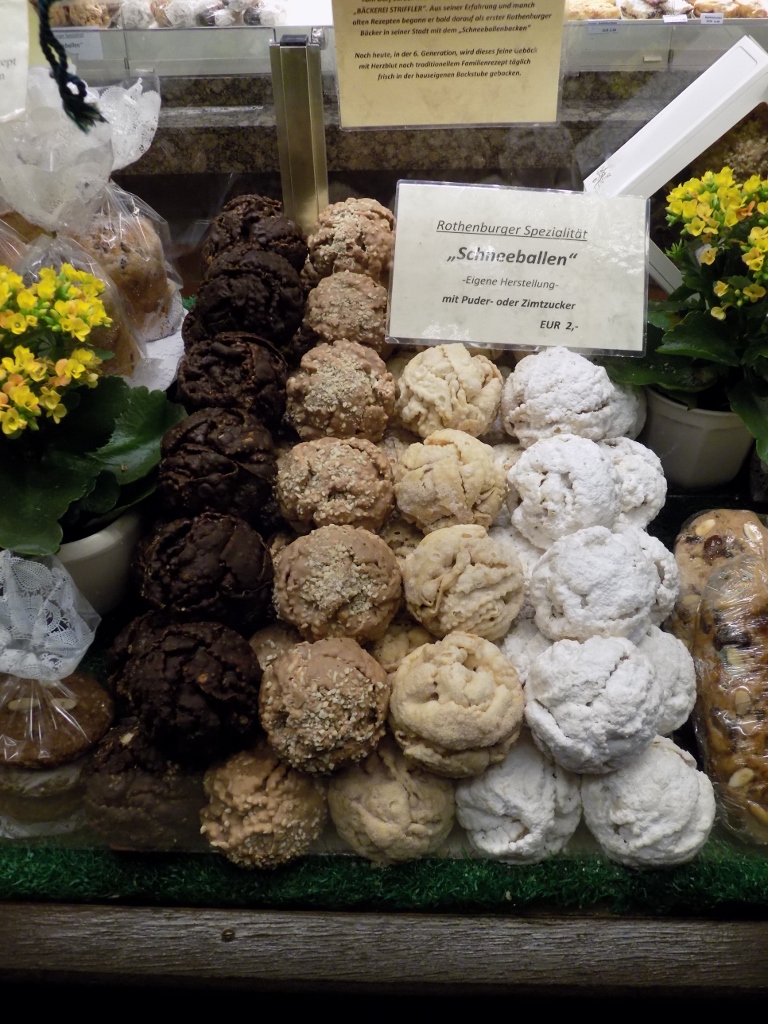 A shop window exhibiting several versions of the Rothenburg’s Schneeballen
A shop window exhibiting several versions of the Rothenburg’s Schneeballen
Talking about shop windows, I also passed by one where I could see ceramic models of traditional houses which were not inexpensive, but were certainly gorgeous.
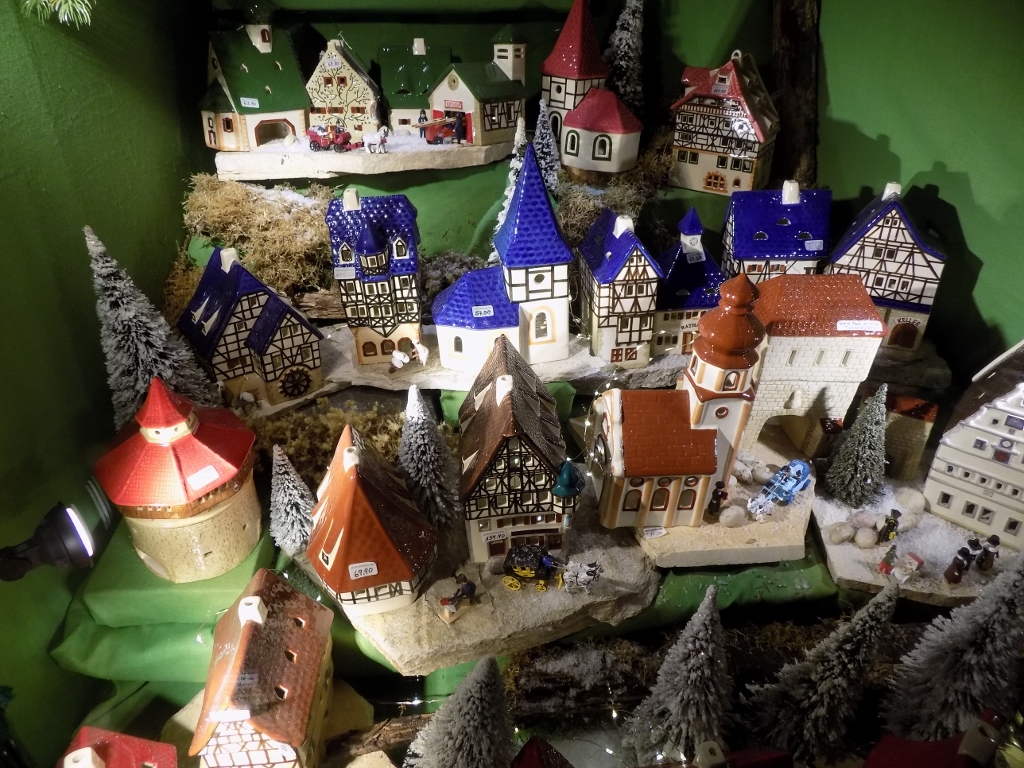 A shop window with small houses-souvenirs from Rothenburg
A shop window with small houses-souvenirs from Rothenburg
By the time I had finished with my coffee and sweets, it was already starting to get dark. Everything continued to be beautiful and fairy-tale-like, but in a different way.
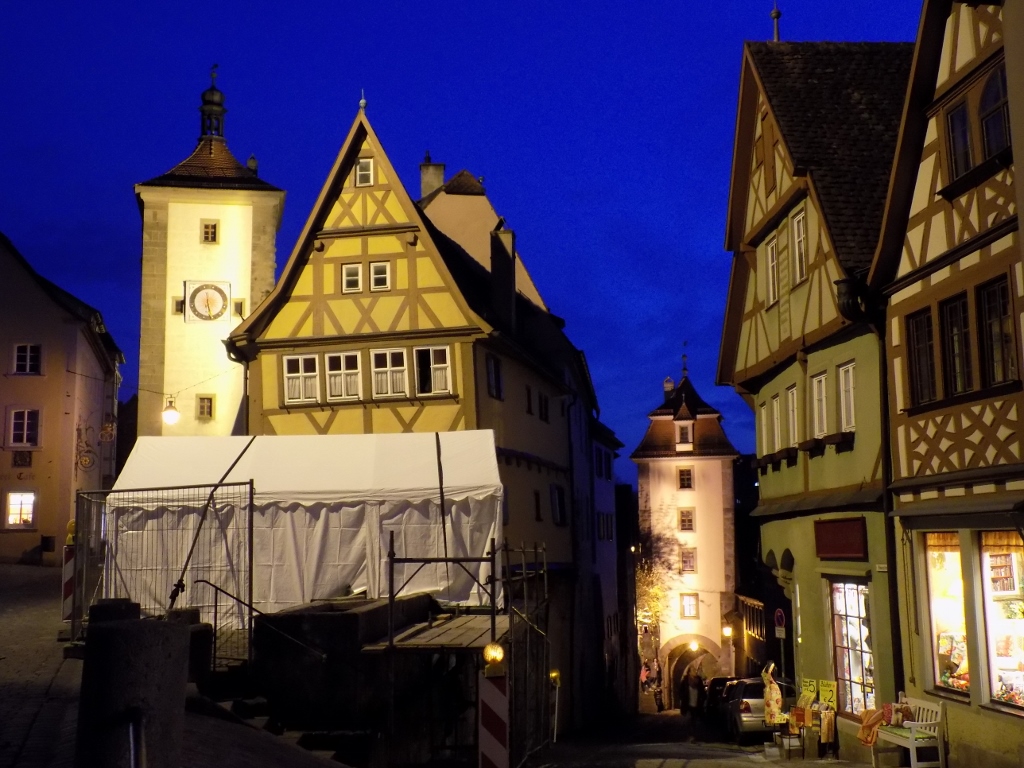 Siebersturm to the left and Kohlturm to the right
Siebersturm to the left and Kohlturm to the right
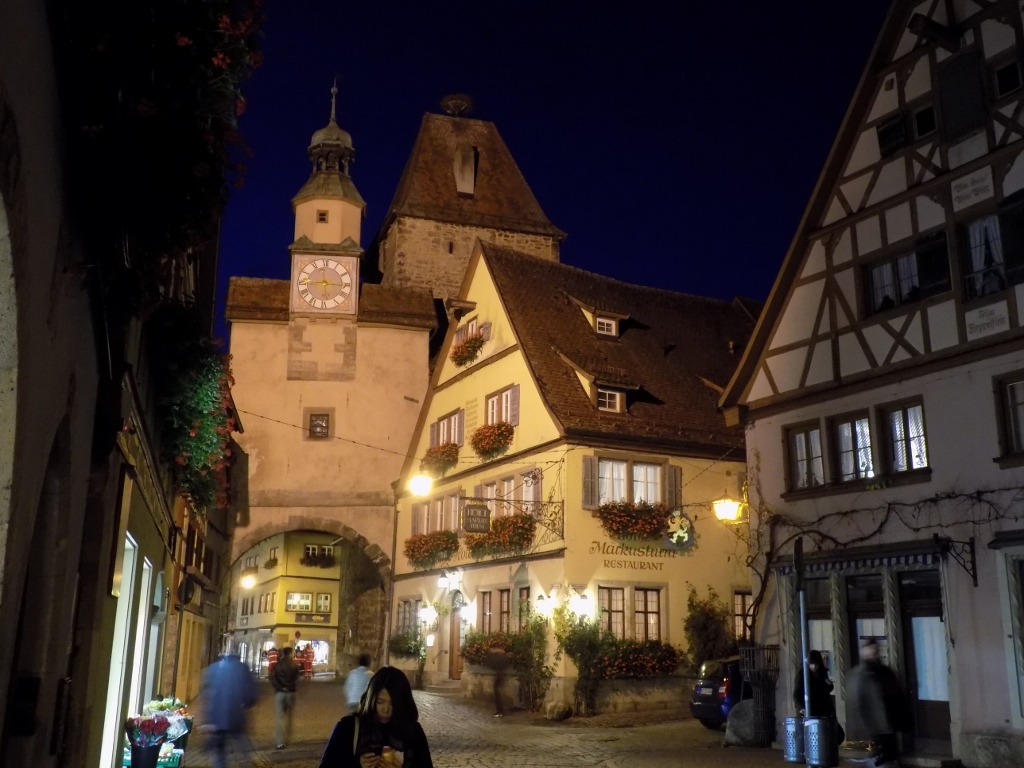 View at Markusturm at night
View at Markusturm at night
Soon I took a train back to Nuremberg, but before going back to the flat, I decided to take a walk around the centre of Nuremberg as well. And I was not disappointed. There were some amazing views here, too.
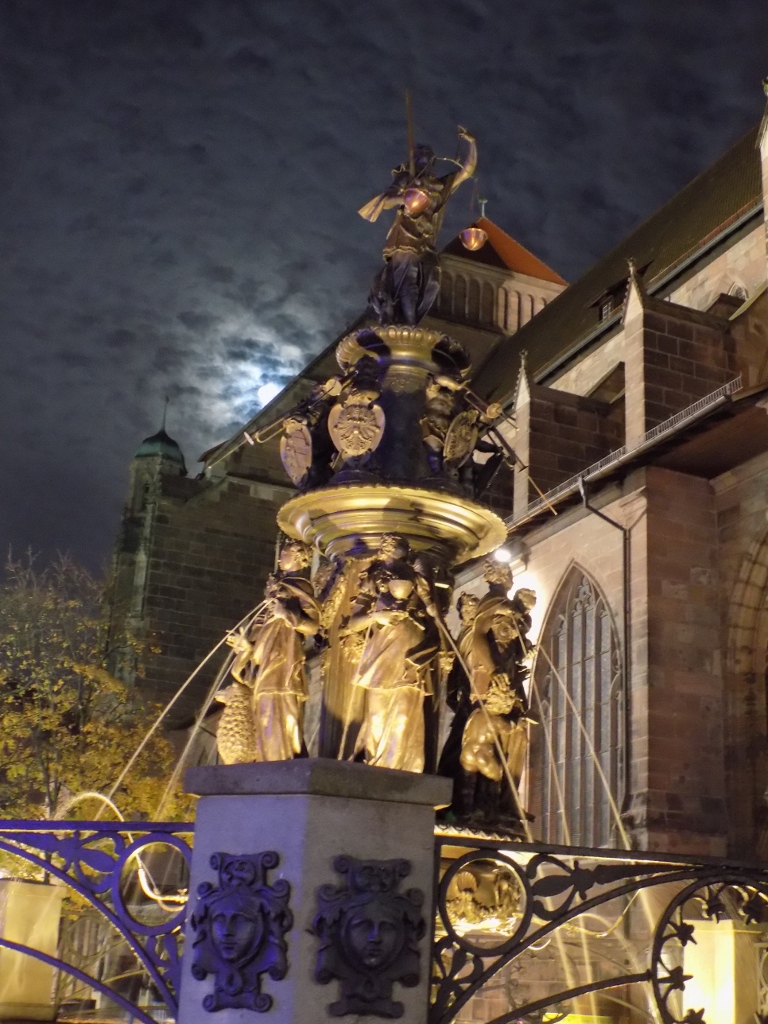 Tugendbrunnen fountain by the Church of St. Lorenz
Tugendbrunnen fountain by the Church of St. Lorenz
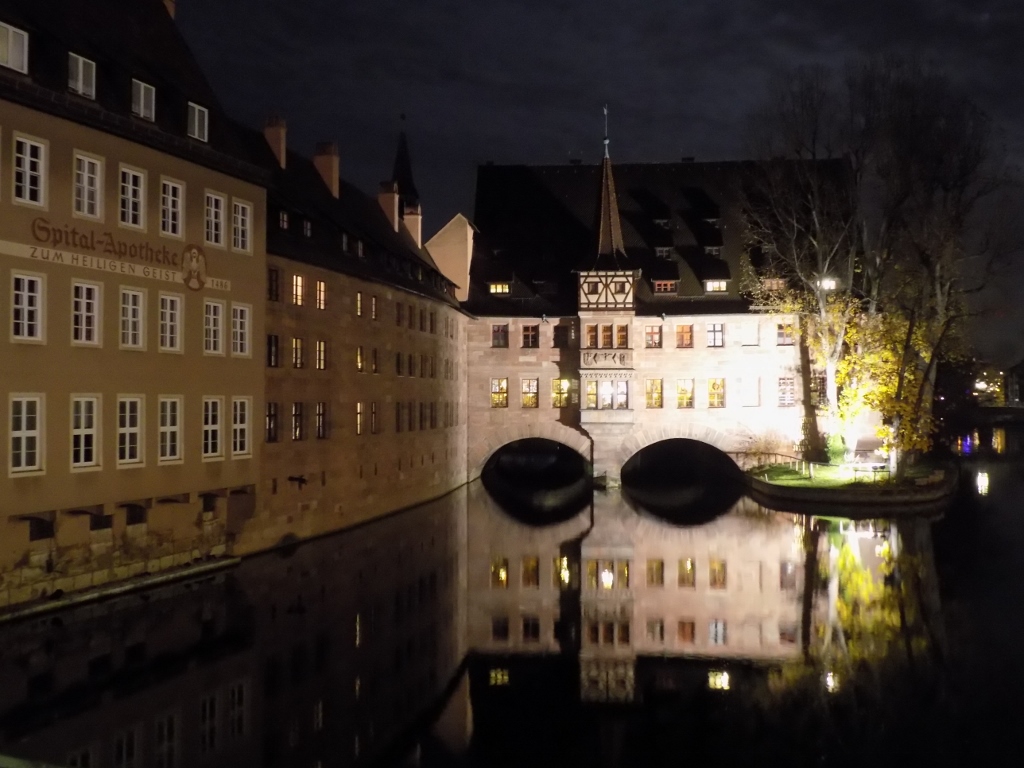 Holy Spirit Hospital at the Pegnitz
Holy Spirit Hospital at the Pegnitz
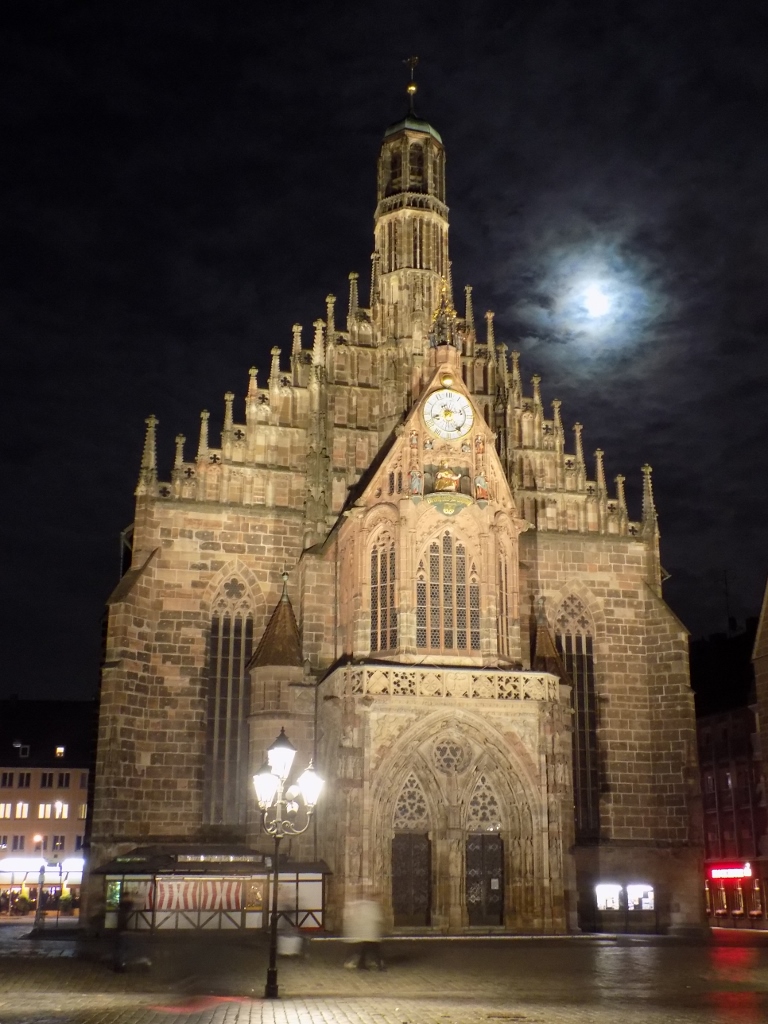 Frauenkirche
Frauenkirche
The next day I went for a leisurely walk around the centre of Nuremberg, but I had also decided to go for the city-tour by a small train that started from the Main Square by the Beautiful Fountain (Schöner Brunnen).
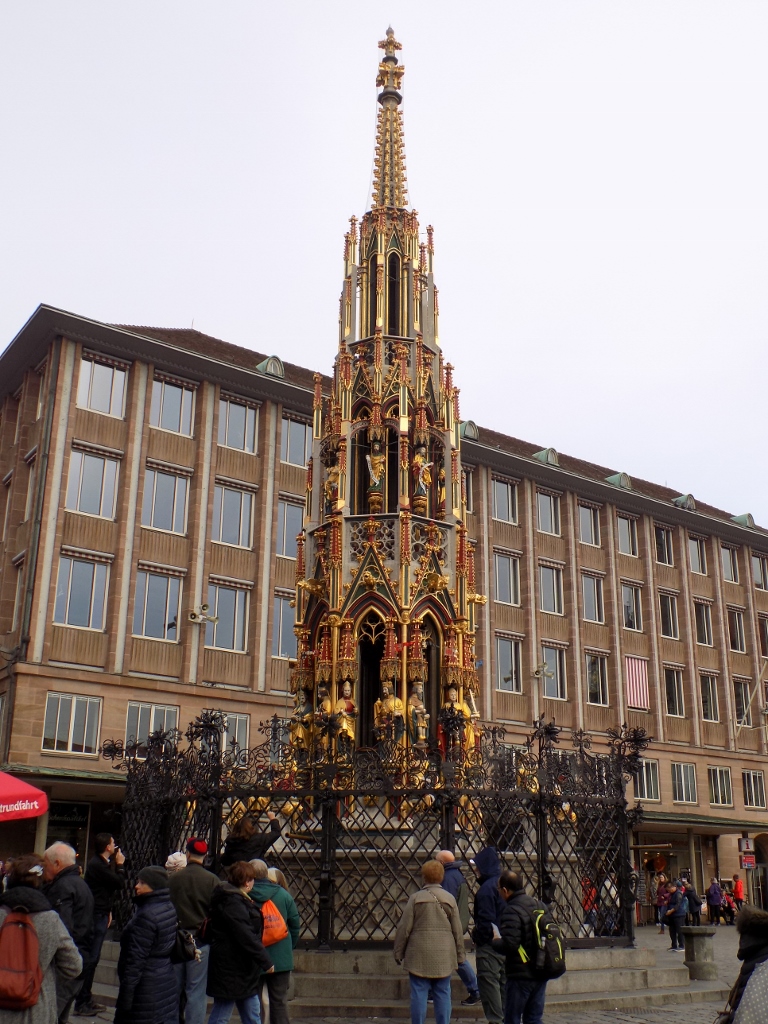 Schöner Brunnen
Schöner Brunnen
This 19 metre tall fountain originates from the 14th century, although the figures that may be seen on it nowadays are in fact copies. What is particularly interesting is that there is a legend about the fountain which says that if you touch one of the rings that may be found on the fence around the fountain, you may have a wish and that wish will come true. While I was sitting on the train, waiting for it to start, the fountain was visited by a group of tourists and they seemed all to stretch quite well in order to reach the ring.
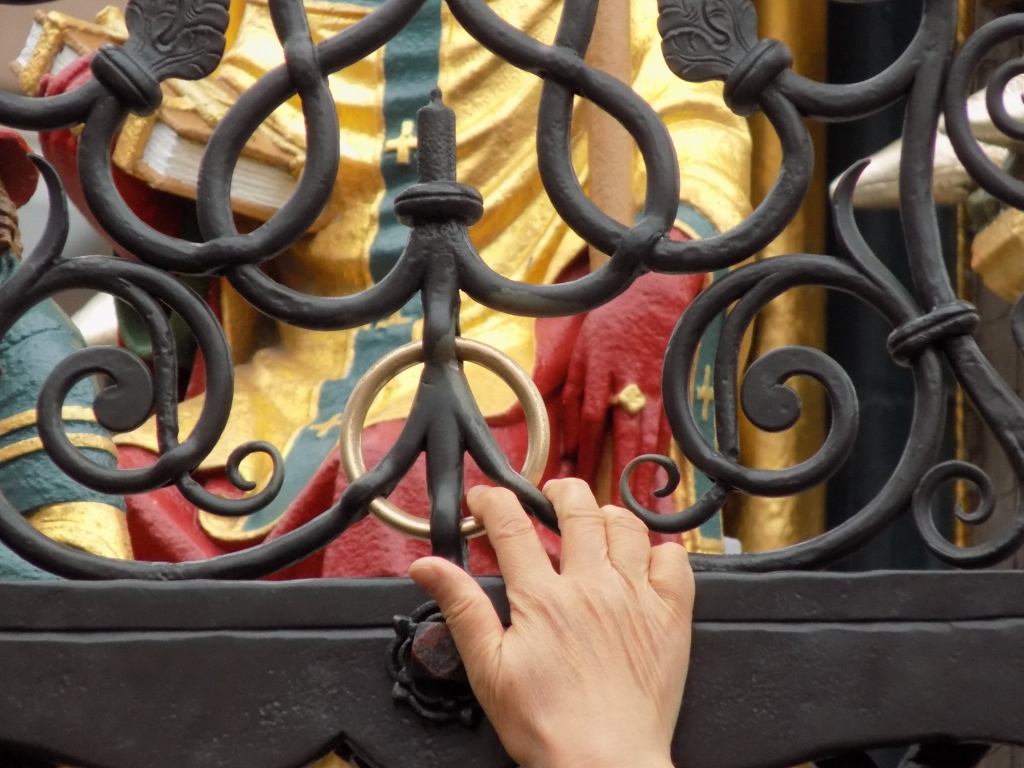 The wishes-granting ring on the Schöner Brunnen fountain
The wishes-granting ring on the Schöner Brunnen fountain
After the tourist circle around Nuremberg by train, I decided to walk for a little while before it started to rain as had been forecasted. However, since it happened that I was at the Main Square at noon, I was present at the little “show” performed by figures on the front of the Frauenkirche.
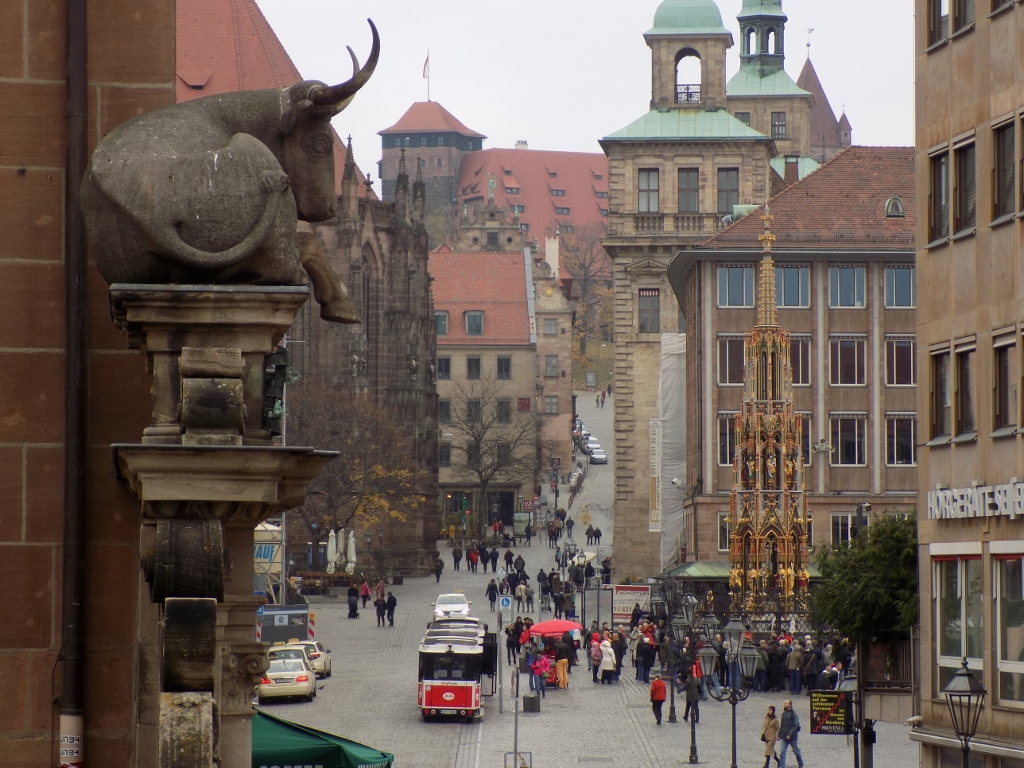 View at the Main Square, the Schöner Brunnen fountain and the small tourist train waiting to take on a new group
View at the Main Square, the Schöner Brunnen fountain and the small tourist train waiting to take on a new group
And yes, it soon started to rain. It was not particularly heavy, but it still fell incessantly. In spite of that, I went to visit a couple of more places, such as the Chain Bridge (Kettensteg) and the Wait Tower (Weißer Turm).
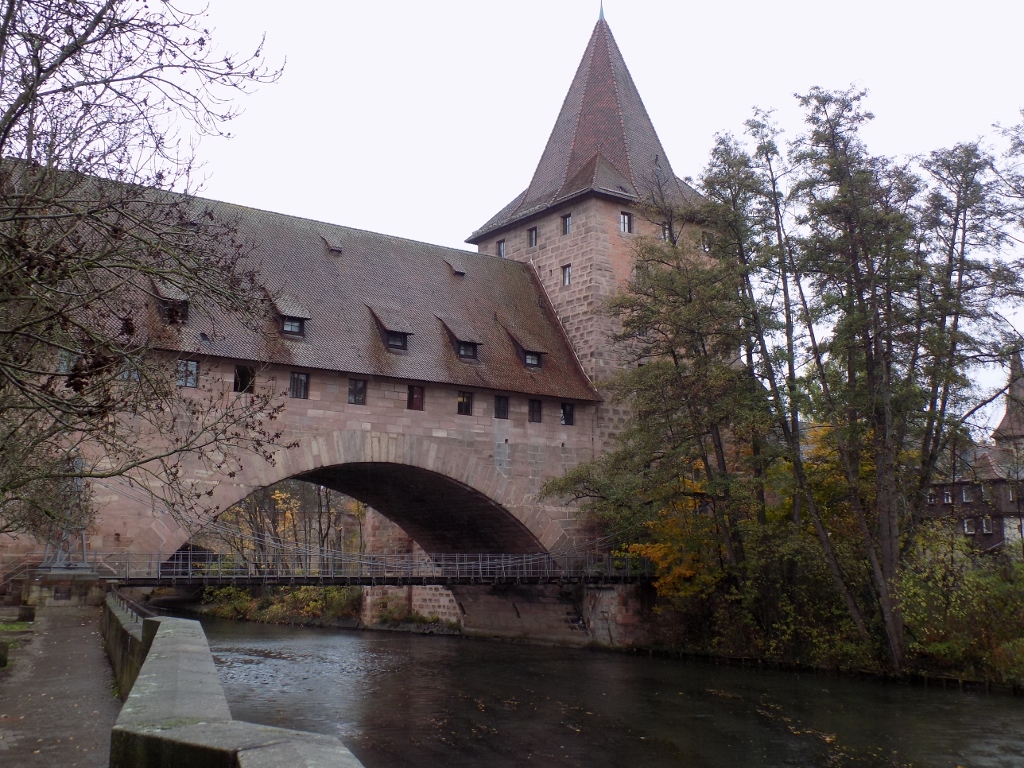 Chain Bridge (Kettensteg)
Chain Bridge (Kettensteg)
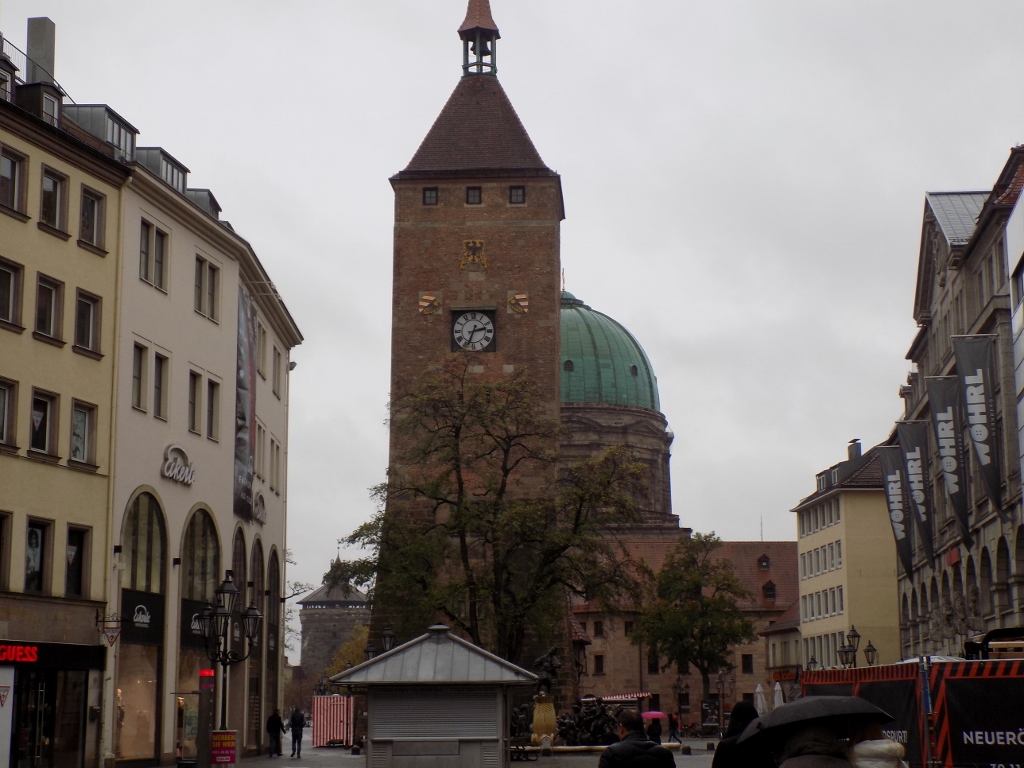 White Tower, with the Church of St. Elisabeth behind it
White Tower, with the Church of St. Elisabeth behind it
The White Tower used to be whitewashed and hence its name, but although the lime has fallen off a long time ago, the name has remained. Near the White Tower, there is also the Church of St. Elisabeth (St. Elisabethkirche), which is very interesting with its circular central part, as well as the church of St. Jacob (St. Jakob).
From a square which in a way brings these three buildings together, there are in the direction of St. Lorenz church a couple of shopping streets and I thought I might go to some of the shops as a way to hide from the rain, but my plan failed. It was Sunday and everything was closed.
In order not to get soaked for no particular reason, I went straight to the main museum, which actually was my basic idea for the rainy afternoon. This is the Germanic National Museum (Germanisches Nationalmuseum). This is the biggest German museum and it was founded around the mid-19th century. It contains an enormous number of exhibits, from prehistory to the present days, although not everything is on display. In addition to the large number of artefacts, the museum also covers a very broad spectrum of themes, from works of art to ethnological exhibits that include everyday objects and from excavated prehistoric remains that testify to the establishment of human culture in this part of the world to fashion and modern clothes. There, it is really possible to see a comprehensive history of Germanic culture in one place.
There were a lot of things I liked there, but I want to single out a group which was made in 1516 by Veit Stoß, entitled The Archangel Raphael and Young Tobias. This group was made of wood and just pay attention to the fantastically skilfully and delicately created folds of the clothes.
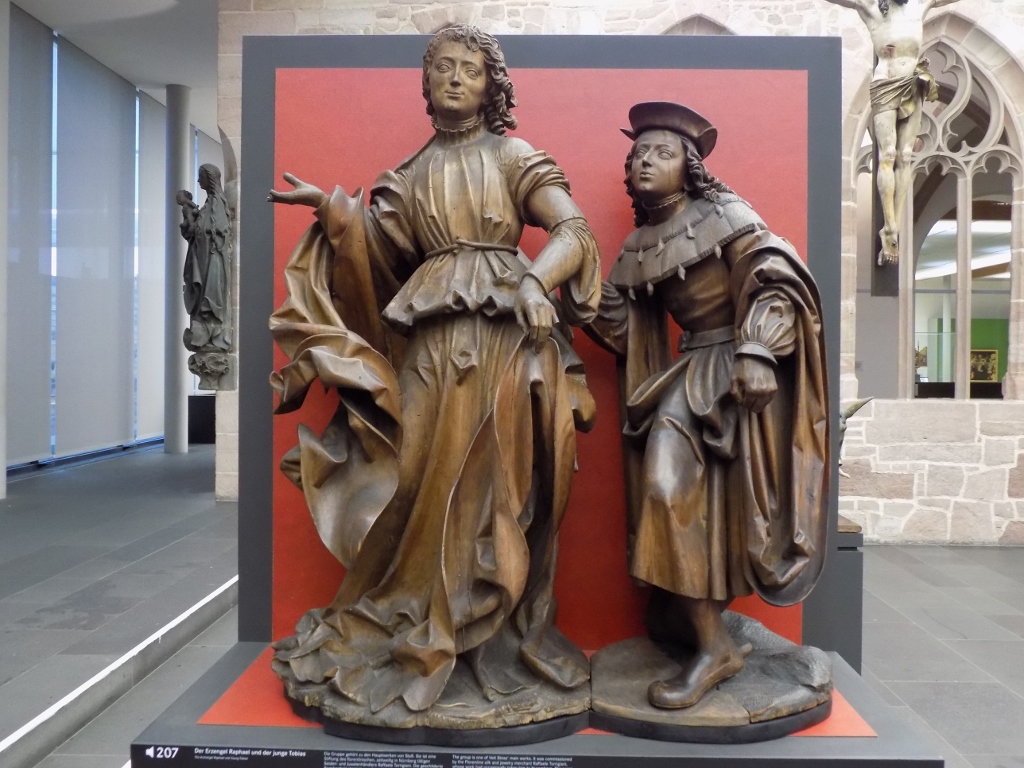 Veit Stoß, The Archangel Raphael and Young Tobias, Germanisches Nationalmuseum
Veit Stoß, The Archangel Raphael and Young Tobias, Germanisches Nationalmuseum
By the time I had left the museum it was already dark and it still rained. Despite this, I decided to walk for a little while yet and thus I accidently reached the “red street,” i.e., a street in which a lot of buildings were lit by red light, while the houses I passed by had large widows of rooms serving as shop-windows. There I could see semi-naked young women. I didn’t look at them closely, but I did notice that most of them were checking their mobile phones. I guess that was the easiest way for them to cut the time while waiting for customers.
Although I was in no particular hurry the next morning, I still had only the time to go to a bakery and have a nice, relaxed breakfast there which, among other things, also included a Bavarian pretzel with butter. As I was in Bavaria, it was a symbolic and very tasty way to mark the ending of my brief visit to this part of Germany.